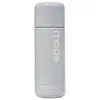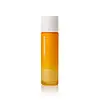What's inside
What's inside
 Key Ingredients
Key Ingredients

 Benefits
Benefits

 Concerns
Concerns

 Ingredients Side-by-side
Ingredients Side-by-side

Water
Skin ConditioningC12-15 Alkyl Benzoate
AntimicrobialCoconut Alkanes
EmollientGlycerin
HumectantPolyglyceryl-3 Oleate
EmulsifyingPolyglyceryl-10 Mono/Dioleate
Skin ConditioningTocopheryl Acetate
AntioxidantSodium Hyaluronate
HumectantSodium Hyaluronate Crosspolymer
HumectantHydrolyzed Sodium Hyaluronate
Skin ConditioningSodium Acetylated Hyaluronate
HumectantCeramide NP
Skin ConditioningCeramide AP
Skin ConditioningCeramide EOP
Skin ConditioningBeta-Glucan
Skin ConditioningCopper Gluconate
Skin ConditioningMagnesium Aspartate
Skin ConditioningOleic Acid
EmollientLinoleic Acid
CleansingLinolenic Acid
CleansingXanthan Gum
EmulsifyingZinc Gluconate
Skin ConditioningEuterpe Oleracea Sterols
Skin ConditioningPhosphatidylglycerol
Phytosphingosine
Skin ConditioningCaprylyl Glycol
EmollientCholesterol
EmollientCoco-Caprylate/Caprate
EmollientPEG-7 Glyceryl Cocoate
EmulsifyingCetyl Hydroxyethylcellulose
Emulsion StabilisingCarbomer
Emulsion StabilisingSodium Lauroyl Lactylate
EmulsifyingPentylene Glycol
Skin Conditioning1,2-Hexanediol
Skin ConditioningSodium Phytate
Phenoxyethanol
PreservativeEthylhexylglycerin
Skin ConditioningSodium Benzoate
MaskingChlorphenesin
AntimicrobialCitric Acid
BufferingWater, C12-15 Alkyl Benzoate, Coconut Alkanes, Glycerin, Polyglyceryl-3 Oleate, Polyglyceryl-10 Mono/Dioleate, Tocopheryl Acetate, Sodium Hyaluronate, Sodium Hyaluronate Crosspolymer, Hydrolyzed Sodium Hyaluronate, Sodium Acetylated Hyaluronate, Ceramide NP, Ceramide AP, Ceramide EOP, Beta-Glucan, Copper Gluconate, Magnesium Aspartate, Oleic Acid, Linoleic Acid, Linolenic Acid, Xanthan Gum, Zinc Gluconate, Euterpe Oleracea Sterols, Phosphatidylglycerol, Phytosphingosine, Caprylyl Glycol, Cholesterol, Coco-Caprylate/Caprate, PEG-7 Glyceryl Cocoate, Cetyl Hydroxyethylcellulose, Carbomer, Sodium Lauroyl Lactylate, Pentylene Glycol, 1,2-Hexanediol, Sodium Phytate, Phenoxyethanol, Ethylhexylglycerin, Sodium Benzoate, Chlorphenesin, Citric Acid
Water
Skin ConditioningLactobacillus Ferment
Skin Conditioning3-O-Ethyl Ascorbic Acid
Skin ConditioningNiacinamide
SmoothingHyaluronic Acid
HumectantSodium Hyaluronate
HumectantPanthenol
Skin ConditioningSodium Polyglutamate
HumectantTocopherol
AntioxidantGlycerin
HumectantCitrus Aurantium Dulcis Peel Extract
Emulsion StabilisingCitrus Aurantium Dulcis Callus Culture Extract
Skin ConditioningCitrus Sinensis Fruit Extract
AntioxidantCitrus Aurantium Dulcis Fruit Extract
MaskingCitrus Aurantium Dulcis Oil
MaskingHippophae Rhamnoides Extract
MaskingLycium Barbarum Fruit Extract
AstringentRosa Canina Fruit Extract
AstringentCitrus Limon Fruit Extract
MaskingGluconolactone
Skin ConditioningLithothamnion Calcareum Extract
Skin ConditioningHelianthus Annuus Seed Oil
EmollientChondrus Crispus Extract
Skin ConditioningLeuconostoc/Radish Root Ferment Filtrate
AntimicrobialCitric Acid
BufferingSodium Riboflavin Phosphate
Skin ConditioningSodium Tocopheryl Phosphate
AntioxidantSodium Citrate
BufferingPotassium Hydroxide
BufferingXanthan Gum
EmulsifyingSodium Benzoate
MaskingCalcium Gluconate
HumectantTriethylhexanoin
MaskingPolyglyceryl-3 Laurate
EmulsifyingAcrylates/C10-30 Alkyl Acrylate Crosspolymer
Emulsion StabilisingPentaerythrityl Tetra-Di-T-Butyl Hydroxyhydrocinnamate
AntioxidantPhenoxyethanol
PreservativeChlorphenesin
AntimicrobialTriethyl Citrate
MaskingLimonene
PerfumingLinalool
PerfumingCitral
PerfumingWater, Lactobacillus Ferment, 3-O-Ethyl Ascorbic Acid, Niacinamide, Hyaluronic Acid, Sodium Hyaluronate, Panthenol, Sodium Polyglutamate, Tocopherol, Glycerin, Citrus Aurantium Dulcis Peel Extract, Citrus Aurantium Dulcis Callus Culture Extract, Citrus Sinensis Fruit Extract, Citrus Aurantium Dulcis Fruit Extract, Citrus Aurantium Dulcis Oil, Hippophae Rhamnoides Extract, Lycium Barbarum Fruit Extract, Rosa Canina Fruit Extract, Citrus Limon Fruit Extract, Gluconolactone, Lithothamnion Calcareum Extract, Helianthus Annuus Seed Oil, Chondrus Crispus Extract, Leuconostoc/Radish Root Ferment Filtrate, Citric Acid, Sodium Riboflavin Phosphate, Sodium Tocopheryl Phosphate, Sodium Citrate, Potassium Hydroxide, Xanthan Gum, Sodium Benzoate, Calcium Gluconate, Triethylhexanoin, Polyglyceryl-3 Laurate, Acrylates/C10-30 Alkyl Acrylate Crosspolymer, Pentaerythrityl Tetra-Di-T-Butyl Hydroxyhydrocinnamate, Phenoxyethanol, Chlorphenesin, Triethyl Citrate, Limonene, Linalool, Citral
 Reviews
Reviews

Ingredients Explained
These ingredients are found in both products.
Ingredients higher up in an ingredient list are typically present in a larger amount.
Chlorphenesin is a synthetic preservative. It helps protect a product against bacteria in order to extend shelf life. In most cases, Chlorphenesin is paired with other preservatives such as phenoxyethanol and caprylyl glycol.
Chlorphenesin is a biocide. This means it is able to help fight the microorganisms on our skin. It is also able to fight odor-releasing bacteria.
Chlorphenesin is soluble in both water and glycerin.
Studies show Chlorphenesin is easily absorbed by our skin. You should speak with a skincare professional if you have concerns about using Chlorphenesin.
Learn more about ChlorphenesinCitric Acid is an alpha hydroxy acid (AHA) naturally found in citrus fruits like oranges, lemons, and limes.
Like other AHAs, citric acid can exfoliate skin by breaking down the bonds that hold dead skin cells together. This helps reveal smoother and brighter skin underneath.
However, this exfoliating effect only happens at high concentrations (20%) which can be hard to find in cosmetic products.
Due to this, citric acid is usually included in small amounts as a pH adjuster. This helps keep products slightly more acidic and compatible with skin's natural pH.
In skincare formulas, citric acid can:
While it can provide some skin benefits, research shows lactic acid and glycolic acid are generally more effective and less irritating exfoliants.
Most citric acid used in skincare today is made by fermenting sugars (usually from molasses). This synthetic version is identical to the natural citrus form but easier to stabilize and use in formulations.
Read more about some other popular AHA's here:
Learn more about Citric AcidGlycerin is already naturally found in your skin. It helps moisturize and protect your skin.
A study from 2016 found glycerin to be more effective as a humectant than AHAs and hyaluronic acid.
As a humectant, it helps the skin stay hydrated by pulling moisture to your skin. The low molecular weight of glycerin allows it to pull moisture into the deeper layers of your skin.
Hydrated skin improves your skin barrier; Your skin barrier helps protect against irritants and bacteria.
Glycerin has also been found to have antimicrobial and antiviral properties. Due to these properties, glycerin is often used in wound and burn treatments.
In cosmetics, glycerin is usually derived from plants such as soybean or palm. However, it can also be sourced from animals, such as tallow or animal fat.
This ingredient is organic, colorless, odorless, and non-toxic.
Glycerin is the name for this ingredient in American English. British English uses Glycerol/Glycerine.
Learn more about GlycerinPhenoxyethanol is a preservative that has germicide, antimicrobial, and aromatic properties. Studies show that phenoxyethanol can prevent microbial growth. By itself, it has a scent that is similar to that of a rose.
It's often used in formulations along with Caprylyl Glycol to preserve the shelf life of products.
Sodium Benzoate is a preservative. It's used in both cosmetic and food products to inhibit the growth of mold and bacteria. It is typically produced synthetically.
Both the US FDA and EU Health Committee have approved the use of sodium benzoate. In the US, levels of 0.1% (of the total product) are allowed.
Sodium benzoate works as a preservative by inhibiting the growth of bacteria inside of cells. It prevents the cell from fermenting a type of sugar using an enzyme called phosphofructokinase.
It is the salt of benzoic acid. Foods containing sodium benzoate include soda, salad dressings, condiments, fruit juices, wines, and snack foods.
Studies for using ascorbic acid and sodium benzoate in cosmetics are lacking, especially in skincare routines with multiple steps.
We always recommend speaking with a professional, such as a dermatologist, if you have any concerns.
Learn more about Sodium BenzoateSodium Hyaluronate is hyaluronic acid's salt form. It is commonly derived from the sodium salt of hyaluronic acid.
Like hyaluronic acid, it is great at holding water and acts as a humectant. This makes it a great skin hydrating ingredient.
Sodium Hyaluronate is naturally occurring in our bodies and is mostly found in eye fluid and joints.
These are some other common types of Hyaluronic Acid:
Learn more about Sodium HyaluronateWater. It's the most common cosmetic ingredient of all. You'll usually see it at the top of ingredient lists, meaning that it makes up the largest part of the product.
So why is it so popular? Water most often acts as a solvent - this means that it helps dissolve other ingredients into the formulation.
You'll also recognize water as that liquid we all need to stay alive. If you see this, drink a glass of water. Stay hydrated!
Learn more about WaterXanthan gum is used as a stabilizer and thickener within cosmetic products. It helps give products a sticky, thick feeling - preventing them from being too runny.
On the technical side of things, xanthan gum is a polysaccharide - a combination consisting of multiple sugar molecules bonded together.
Xanthan gum is a pretty common and great ingredient. It is a natural, non-toxic, non-irritating ingredient that is also commonly used in food products.
Learn more about Xanthan Gum